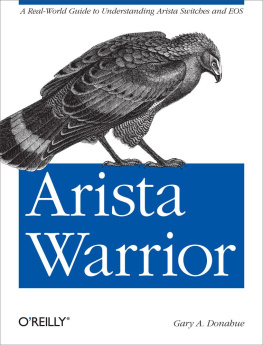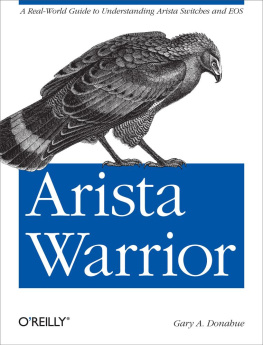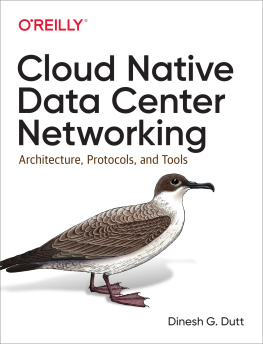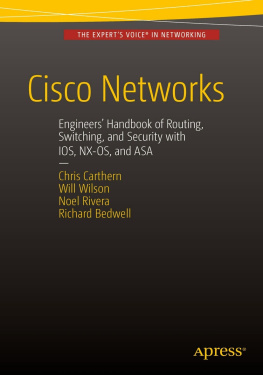The examples used in this book are taken from my own experiences, as well as from the experiences of those with or for whom I have had the pleasure of working. Of course, for obvious legal and honorable reasons, the exact details and any information that might reveal the identities of the other parties involved have been changed.
Who Should Read This Book
This book is not an Arista manual. I will not go into the details of every permutation of every command, nor will I go into painful detail of default timers, or counters, or priorities, or any of that boring stuff. The purpose of this book is to get you up and running with an Arista switch, or even a data center full of them. Whats more, this book aims to explain Arista-specific features in great detail; however, it may not go into such detail on other topics such as explaining VLANs, routers, and how to configure NTP, since Ive covered those topics at length in Network Warrior . I will go into detail if a topic is being introduced here that wasnt covered in Network Warrior , such as Multiple Spanning Tree (MST), or VRRP. Where possible, I have concentrated on what makes Arista switches great. In short, if you want to learn about networking, pick up Network Warrior . If you want to know why Arista is stealing market share from all the other networking equipment vendors, buy this book.
This book is intended for use by anyone familiar with networking, likely from a Cisco environment, who is interested in learning more about Arista switches. Anyone with a CCNA or equivalent (or greater) knowledge should benefit from this book, but the person who will get the most from this book is the entrenched admin, engineer, or architect who has been tasked with building an Arista network. My goal in writing Arista Warrior is to explain complex ideas in an easy-to-understand manner. Ive taught a few classes on Arista switches, and I see trepidation and fear of the unknown in students when the class begins. By the end of the class, I have students asking when Arista will go public, and if I can get them Arista T-shirts (I dont know, and I cant, but thanks for your emails!). I hope you will find this book similarly informative.
As I wrote in Network Warrior , I have noticed over the years that people in the computer, networking, and telecom industries are often misinformed about the basics of these disciplines. I believe that in many cases, this is the result of poor teaching or the use of reference material that does not convey complex concepts well. With this book, I hope to show people how easy some of these concepts are. Of course, as I like to say, Its easy when you know how, so I have tried very hard to help anyone who picks up my book understand the ideas contained herein.
Lets be brutally honest, most technology books suck. What drew me to OReilly in the first place is that almost all of them dont. From the feedback Ive received over the years since first writing Network Warrior , it has become clear to me that many of my readers agree. I hope that this book is as easy to read as my previous works.
My goal, as always, is to make your job easier. Where applicable, I will share details of how Ive made horrible mistakes in order to help you avoid them. Sure, I could pretend that Ive never made any such mistakes, but anyone who knows me will happily tell you how untrue that would be. Besides, stories make technical books more fun, so dig in, read on, and enjoy watching me fail.
This book is similar in style to Network Warrior , with the obvious exception that there is no (well, very little, really) Cisco content. In some cases I include examples that might seem excessive, such as showing the output from a commands help option. My assumption is that people dont have Arista switches sitting around that they can play with. This is a bit different than the Cisco world, where you can pick up an old switch on the Internet for little money. Arista is a relatively new company, and finding used Arista switches will probably be tough. Hopefully, by including more of what youd see in an actual Arista switch, this book will help those curious about them.
Lastly, Id like to explain why I wrote this book. I dont work for Arista, I dont sell Arista gear, and Arista has not paid me to write this book. Some time ago, a client had me do a sort of bake-off between major networking equipment vendors. We brought in all the big names, all of whom said something to the effect of, Were usually up against Arista in this space! Because every one of the other vendors inadvertently recommended Arista, we contacted them, got some test gear, and went out to visit their California office.
Ive been in IT for almost 30 years, and Ive been doing networking for 25. Im jaded, Im grouchy, and I distrust everything I read. Ive seen countless new ideas reveal themselves as a simple rehashing of something we did with mainframes. Ive seen countless IT companies come and go, and Ive been disappointed by more pieces of crappy hardware with crappy operating systems than most people can name. Ive been given job offers by the biggest names in the business, and turned them all down. Why? Because big names mean nothing to me aside from the possibility of another notch added to my resume.
Nothing impresses me, nothing surprises me, and nothing gets past me. But when I walked out of Arista after three days of meeting with everyone from the guys who write the code to the CEO and founders themselves, I was impressed. Not only impressed, but excited! Im not easily sold, but I walked out of there a believer, and in the short years since that first introduction, nothing has caused me to change my perception of Arista and their excellent equipment.
When I started writing, there were no Arista books out there. I felt that I could write one that people would enjoy, while doing justice to the Arista way of doing things. As you read this book, I hope that youll get a feel for what that way is.
Though Im obviously a fan, these devices are not perfect. Ill show you where Ive found issues, and where there might be gotchas . Thats the benefit of me not being paid by AristaIll tell it like it is. To be honest though, in my experience, Arista would tell you the very same things, which is what first impressed me about them. Thats why I wrote this book. Its easy for me to write when I believe in the subject matter.
Enough blatherlets get to it!
Conventions Used in This Book
The following typographical conventions are used in this book:
ItalicUsed for new terms where they are defined, for emphasis, and for URLs
Constant widthUsed for commands, output from devices as it is seen on the screen, and samples of Request for Comments (RFC) documents reproduced in the text
Constant width italicUsed to indicate arguments within commands for which you should supply values
Constant width boldUsed for commands to be entered by the user and to highlight sections of output from a device that have been referenced in the text or are significant in some way
Note
Indicates a tip, suggestion, or general note








